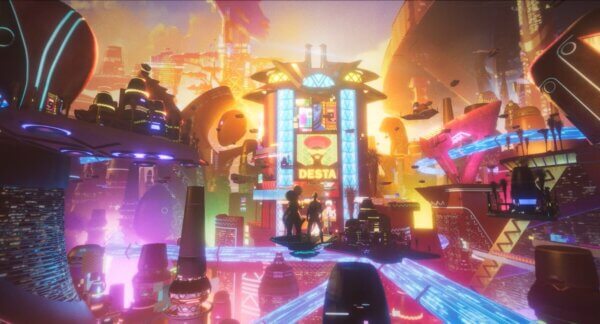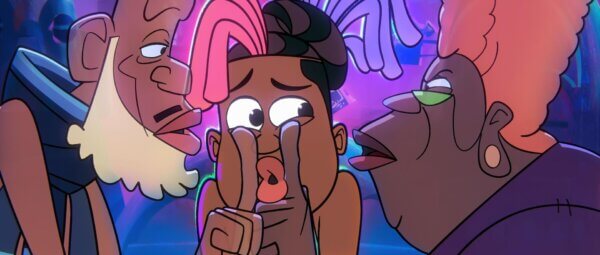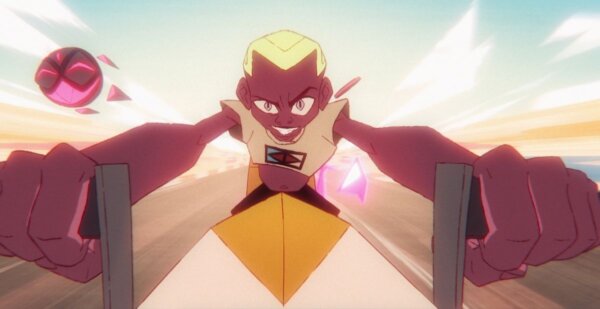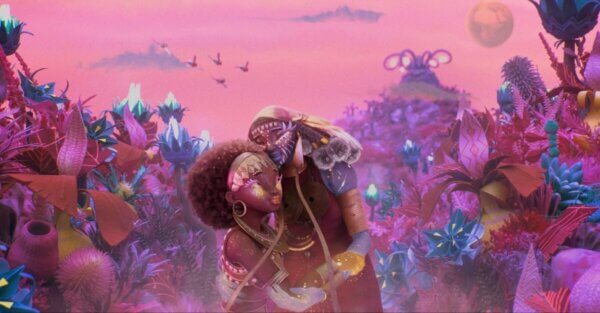Kizazi Moto: Generation Fire Interview
Kizazi Moto: Generation Fire is distributed under Disney, the writers and actors for which are currently on strike due to unfair working conditions, compensation and a refusal on the part of the studios to properly regulate AI. The Writers Guild are not calling for a boycott on coverage of their work. Skwigly stands with the WGA and SAG-AFTRA.
The filmmaking experience for black and brown people is not always conducive to creative freedom. Particularly when handling projects for mega-corporations who want to be seen as diverse to get the young people on board, but not too diverse as to not piss off their loyal conservative customers. This leads to a drip feed of opportunities for creators from diverse backgrounds. A director is handpicked to handle a multi-million dollar project on the biggest stage with the expectations of a corporation and the anxiety of accurately depicting their community on their shoulders.
When caught between expectations like this, it’s hard to be relaxed and creative. If you handle this project well, and a few more down the line, maybe then you’ll have the chance to do something you really want to do. Kizazi Moto: Generation Fire asks the question “Why can’t we be introduced to POC directors at their most creative?”
The anthology brings together a wealth of creatives from the African continent for 10 uniquely African short films to be showcased on Disney+ without compromise. Series producers Tendayi Nyeke, Peter Ramsey and Anthony Silverston were not pushing their directors to tick boxes, but instead to focus on their creativity, to push the design of their sci-fi worlds to ensure Kizazi Moto was unlike anything else seen on the mainstream stage.
This leads to the co-existence of stop motion, 2D and CGI animation in Enkai, or the whacky premises of the anime-inspired Mkhuzi: The Spirit Racer and the Hanna-Barbera-influenced First Totem Problems. Advanced technology and spirituality combine and clash as the show tackles issues ranging from coming of age to decolonisation.
Skwigly caught up with Nyeke, Ramsey and Silverston to discuss their roles in ushering their directors in the right direction while leaving room for them to create how they see fit.
How did each of you arrive on the project?
Tendayi: I met Anthony when I was researching animation in Africa, then a year later, he’s like, ‘Hey, we’re doing something about animation in Africa, do you want to join?’ And I said yes. I came onto the project when there was a pitch deck, and then it was about ‘can you help us execute it?’
Anthony: I’m a partner at Triggerfish and so I oversee all the creative direction of the different projects in development. But this project actually was pitched to us by one of our team more in publicity, but he had this great idea, because he’d seen how all these other countries are talked about at conferences and things about the future of China or France, or whatever, but not Africa. He read a lot of Afro-futurist short stories and so he was telling us, ‘Wouldn’t this be nice to do.’ We’ve also been looking at trying to figure out how we could train up more directors on the continent, because we had writer labs, but directors, who work on a feature, you get one for three years, and we wanted more directors to get that opportunity. So we basically started putting together this pitch, and were very lucky to bring Tendayi on and then Peter, who I’d met before.
Peter: I had the chance to go to the Cape Town Animation Festival in 2019, after Spider-verse was finished, and I met all these guys there. I also met a lot of the people who ended up being filmmakers on Kizazi Moto. And I was just so blown away by the energy. It’s a different energy than in the States. These are like people who were genuine and enthusiastic and really had something to say. It was a really special industry that they had there. And so when Stewart from triggerfish got in touch with me to see if I’d be interested in participating in this, I was like, ‘Yes, I would love it.’ Because, honestly, I really love all the guys, all the creators. I had a fantastic time being with them. So the whole thing was a pleasure for me from start to finish.
Could you talk about taking that classic sci-fi anthology format, and adapting it to Afrofuturism?
Tendayi: We don’t use the word Afro-futurist! Part of that is we are seeing science fiction, but through the context of Africa, and trying to demystify Afrofuturism. It’s not a genre for us. Because, you start to raise questions like can a French person do an afro futurist movie? And what does that even mean? So it’s an African filmmaker using science fiction as a medium to communicate. Science fiction allows them to imagine big futures. I love when a lot of Western science fiction is looking at a dystopian context, we’re looking at hope. It really comes from trauma in some ways, though we have a rich heritage prior to the trauma. And then we’re like, hey, technology is evolving. We’re evolving as human beings. If there was hope, what could that look like? Science fiction as a medium allows you to explore that just by its design.
Peter: There’s all these things present in African culture already. A lot of the world, I think, is going to look at these shorts and recognise stuff from pop culture. Gaming, comics, all that stuff is like, ‘Yeah, guess what? Africans are at the forefront of that as well.’ So I think it’s gonna be an eye opener for a lot of people.
Anthony: To speak to the anthology part of it, the opportunities that it allows or creates because now you’re getting more stories and more directors, I think that was really important too. Because when you can only tell one story, you get that one shot, there’s a lot of pressure.
How important was it to showcase different art styles?
Peter: Very. It was all determined by the individual artists, there was no, “you’re going to do stop motion and you’re going to do 2D,” there was none of that. It was like, “what do you feel is the best way to tell your story, and we will, will support you in that.”
Anthony: And a lot of them are artists themselves. So they just did the film in their own style.
Tendayi: We were pushing them to go, “what would tech look like in your underwater world? Are you referring to biomimicry? Are you referring to nanotechnology? Would this community be more grounded in tech? With [episode three] “Moremi”, they wanted that 60s, 70s tech feel, as if we were not colonised and that was a technology. So it was super cool to now be designing these worlds. Like what’s the transport system? With [episode six] “Mukudzei” we have winnowing baskets from Zimbabwe. They’re often associated with witches, you know how in Western culture witches travel with brooms? In our culture, witches travel on the winnowing basket. The director was like, “what if we made made it the transport mode, like your surfboard in the sky?” So we were saying, look at your own culture and communities and how would that technology advance in your world? When you look at the film’s carefully, you actually start to see one of the robots has this hat that’s inspired by a weed hat in Uganda. So it was very cool, science fiction in an African context was really cool to explore in worldbuilding.
Episode two, Mhkuzi: The Spirit Racer, features a half human, half alien character competing in an F1 style tournament. Could you talk about blending those kinds of ideas together?
Peter: Part of that is this whole recurring theme of reconciling your past and your present or your history and your heritage and how you come to peace with that in order to move forward as a more realised person or more realised culture. That’s a big thread that goes through a lot of “Mhkuzi.” Head on it tackles this idea of a complex dual heritage and managing that.
Anthony: “Mhkuzi” is an interesting example, because Malcolm Wope, and [Simangaliso ‘Panda’ Sibaya], they each had come with different stories when they initially pitched to us and there were certain similarities across them. We just thought it’d be really interesting to see what they did together. They each brought their own visual style like Panda is very wacky and just fun and Malcolm’s got that kind of manga influence and so I think that they’re such interesting mixes. It’s a half alien, half human human story as well.
Tendayi: Soweto, where Panda comes from this big street racing culture. That’s what he wanted to do. He was riffing off that in the future where aliens are also competing with us. So he just literally took his own backyard as an inspiration for the context of the film.
Enkai has a magical look about it. What was it like developing that specific style?
Peter: The director, Ng’endo Mukii, she’s like, she’s a poet, she’s a real artist and her story is about these gods with the ability to create life and create worlds. I remember saying, “God, so your story ends with maybe the earth dying?” But she stuck to her guns and there was a lot of reshaping that she did. It was a real discussion and a real conversation and she would take our notes and interpret them and incorporate them in her own way. I was still wondering how this one was gonna come out, and seeing that finished film was just jaw dropping. When you see the stop motion world come to life, I don’t know, it all kind of clicked.
Anthony: She is an artist in just so many ways. She’s worked in 2D and stop motion and so there were questions in the beginning, like, which format should we do? And it sort of ended up all of them? I think even the little character that came to life, that was a little sketch in one of the meetings that became the design.
Tendayi: She was bored in a meeting and she was scribbling and then that scribble became the little character.
Why do you think audiences are more ready for experimentation in animation?
Peter: I mean, I think they always have been, depending on the format. One of the things when we were doing spider-verse, that’s playing with lots of different styles and aesthetics, a lot of dynamism and diversity within that movie, that was important for American feature audiences. But if you looked at the world of shorts, or music videos, or commercials, that’s where the real experimentation was happening in a way that the American features were nowhere near. And we were like, “Why can’t we have some of that?” So I feel like a lot of that stuff was already present and a lot of these directors were already doing that. It’s something that’s been out in the world and I think the short form is kind of easier to digest.
Anthony: I think by focusing on the character driven stories, it’s so that when it’s connected with character, then it’s almost like it doesn’t matter what the animation looks like.
Kizazi Moto: Generation Fire is now streaming on Disney+





